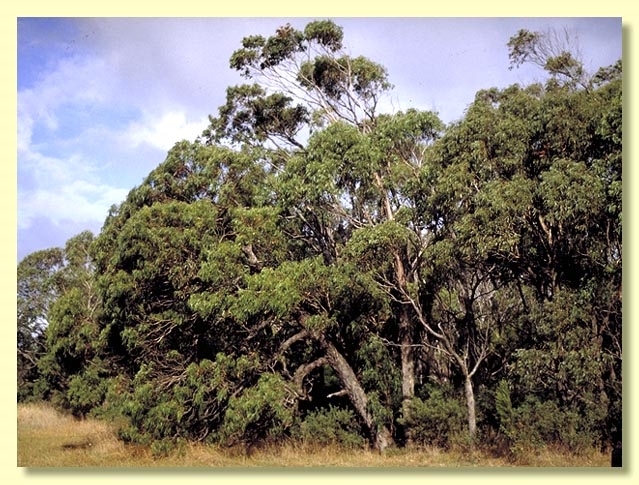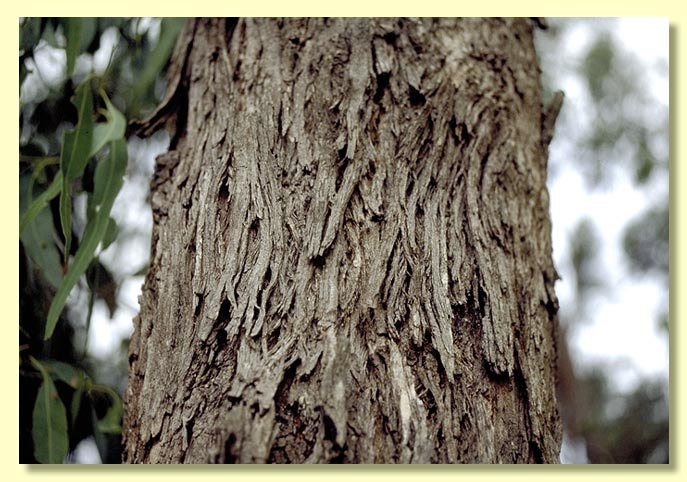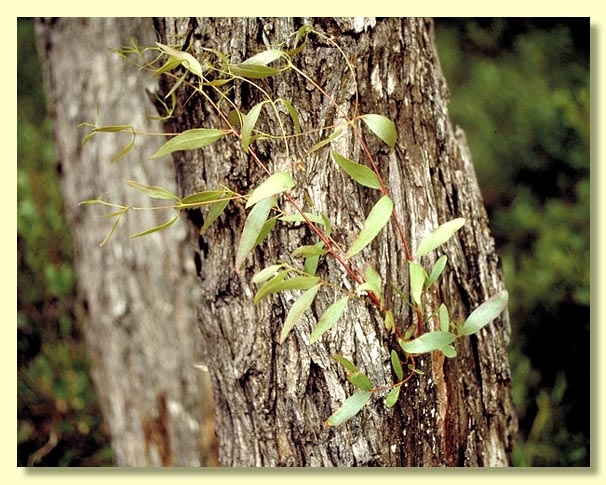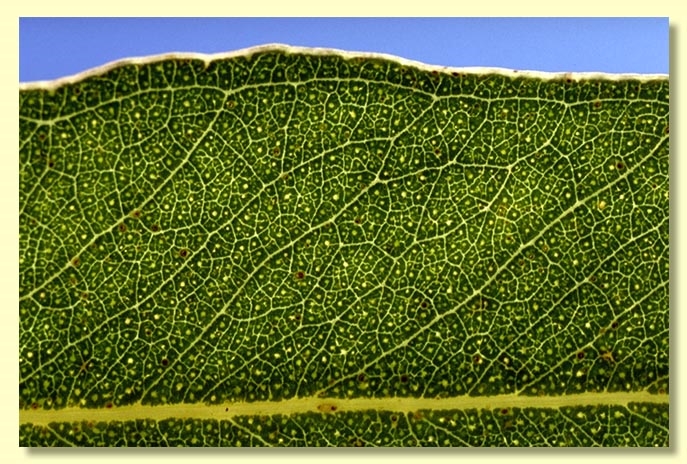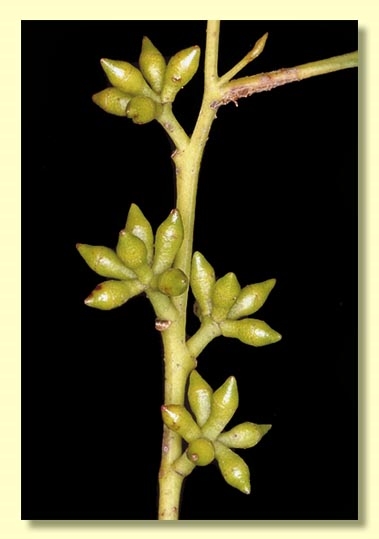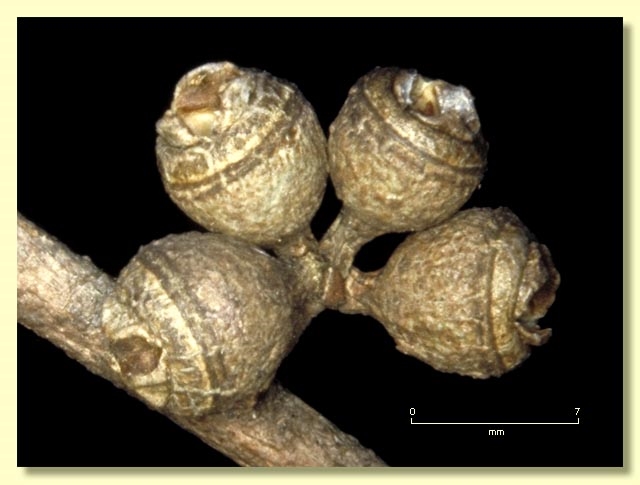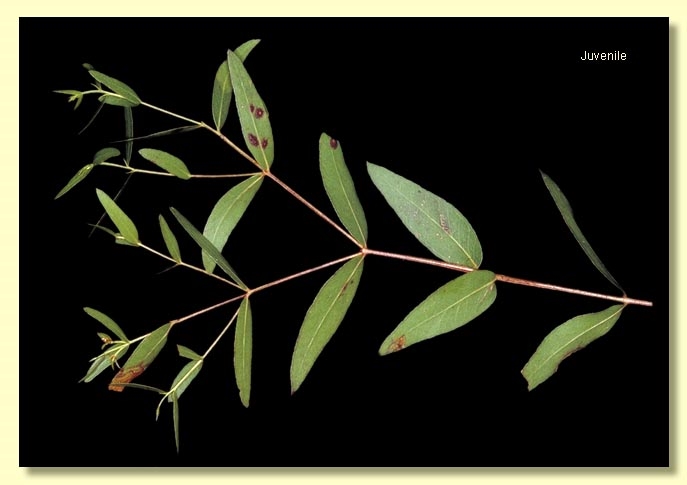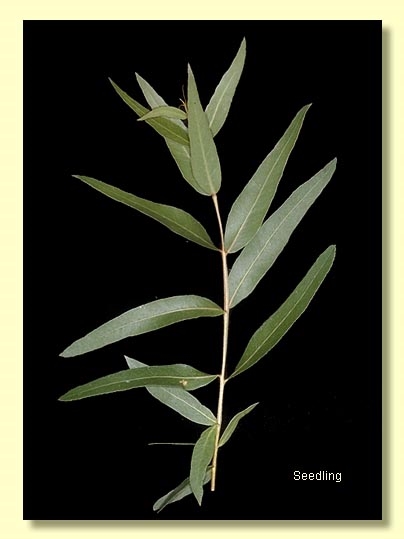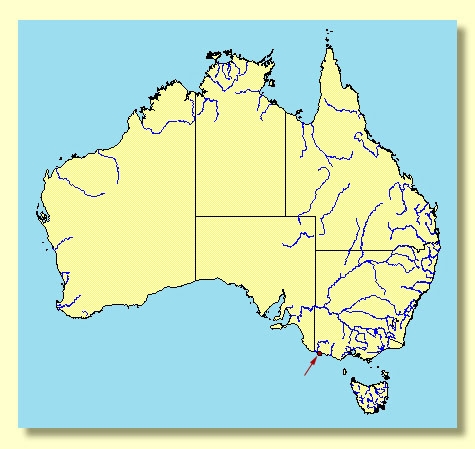Euclid - Online edition
Eucalyptus splendens subsp. splendens
Eucalyptus | Symphyomyrtus | Maidenaria | Euryotae | Viminales | Lanceolatae
T: On the eastern perimeter of the Mt Richmond settlement, Portland - Nelson road, 29 Sept. 1992, K.Rule 9272; holo: MEL.
Bark rough to 4 cm diameter branches, firm to corky fibrous, hardly furrowed, grey or black.
Juvenile growth (coppice or field seedlings to 50 cm): stem square in cross-section and slightly winged, smooth or warty; juvenile leaves opposite for 10–20 nodes then alternate (but occasionally reverting to opposite for a few nodes), sessile or shortly petiolate, lanceolate, 4.5–9 cm long, 1–2.5 cm wide, base rounded or tapering to short petiole, margin entire or scarcely crenulate, slightly discolorous, green, glossy.
Adult leaves alternate, petiole 1–3 cm long; blade lanceolate to falcate, 10–25 cm long, 1.5–2.5 cm wide, base tapering to petiole or sometimes rounded, concolorous, glossy, green, side-veins at an acute or wider angle to midrib, densely reticulate, intramarginal vein parallel to and remote from margin, oil glands mostly island.
Inflorescence axillary unbranched, peduncles 0.4–0.6 cm long, buds 7 per umbel, pedicels 0.1–0.4 cm long. Mature buds ovoid to fusiform, ca 0.5 cm long, ca 0.2–0.3 cm wide, green, scar present, operculum conical or slightly beaked, stamens all inflexed or a few irregularly flexed, all fertile, anthers cuboid, versatile, sub-basifixed, dehiscing by longitudinal slits (non-confluent), style long, stigma blunt or more or less pinhead, locules 3 or 4 (rarely 5), the placentae each with 4 vertical ovule rows. Flowers white.
Fruit on pedicels to 0.3 cm long, rarely sessile, hemispherical or cupular, 0.5–0.6 cm long, 0.5–0.8 cm wide, disc raised-convex to oblique, valves 3 or 4 (rarely 5), exserted.
Seeds dark brown to reddish brown, 1.5–3 mm long, ovoid or flattened-ovoid, often pointed at one end, usually lacunose, dorsal surface pitted, hilum ventral.
Cultivated seedlings (measured at ca node 10): cotyledons bilobed to oblong; stems square in cross-section, warty or smooth; leaves sessile and opposite for at least 14-24 nodes, lanceolate, 5.5–8.8 cm long, 1.2–1.8 cm wide, base rounded to tapering, never stem-clasping, slightly glossy, green.
Flowering time unknown.
Eucalyptus splendens (with two subspecies) is a small to medium-sized rough-barked tree so far known from three scattered localities viz. Moonlight Head and near Mt Richmond in coastal western Victoria, and near Carpenter Rocks on the coast of South Australia, west of Mt Gambier. It is completely rough-barked, has glossy green adult leaves, bright glossy green juvenile leaves that remain sessile and opposite for many nodes and are not stem-clasping but taper basally; seedling and juvenile stems in E. splendens are square in cross-section.
There are two subspecies:
E. splendens subsp. splendens
An erect tree to 10 m tall with lanceolate juvenile leaves to 9 cm long and 2.5 cm wide, and acutely conical buds. Adult leaves are 10-25 cm long. It is confined to the Mount Richmond locality.
E. splendens subsp. arcana
A small straggly tree to ca 4 m tall, with ovate to ovate-lanceolate juvenile leaves to 12 cm long and 5.5 cm wide, and buds that are bluntly conical compared with subsp. splendens. Adult leaves are 8-15 cm long. It is known from the vicinity of Carpenter Rocks in South Australia and at Moonlight Head in Victoria.
Eucalyptus splendens has somewhat obscure affinities and has been allied to both the E. viminalis and the E. aromaphloia groups of species in the past. It differs from E. viminalis because the juvenile leaves are not stem-clasping (always stem-clasping in E. viminalis, never stem-clasping in E. aromaphloia), and it differs from E. aromaphloia in having juvenile stems squared in cross-section (always rounded in E. aromaphloia, rounded to more or less squared in E. viminalis). All three species have basically similar bud, fruit and seed features, though number of buds per umbel and dimensions may differ.
In the classification of Brooker (2000) Eucalyptus splendens is placed in Eucalyptus subgenus Symphyomyrtus section Maidenaria, a large group of species more or less restricted to south-eastern Australia, characterised by bilobed cotyledons, simple axillary inflorescences, buds with two opercula the outer of which sheds early in bud development, stamens with versatile anthers and flattened seeds with a ventral hilum. Within this section, Brooker places E. splendens in series Viminales subseries Lanceolatae, having buds in sevens, fruit with an ascending disc and exserted valves, and green, sessile, lanceolate juvenile leaves opposite for many pairs, and this is followed in EUCLID. E. splendens differs most notably from other species in series Viminales by the tapering (not stem-clasping) leaf-bases of the juvenile leaves and the conspicuously squared juvenile stems. Nicolle (2006) stated that the taxonomic relationship of E. splendens is with series Acaciiformes which also includes E. aromaphloia, while Rule (1996) also suggested that its affinity is with E. aromaphloia.
Plants at Moonlight Head in Victoria are regarded by Nicolle (2006) as being subsp. arcana but are considered by other botanists (e.g. Chappill et al (1986) and Rule (2009)) to be close to E. aromaphloia (subsp. aromaphloia). Eucalyptus splendens subsp. arcana (from Carpenter Rocks) is regarded by Rule (ibid.) as a species (i.e. Eucalyptus arcana ).

